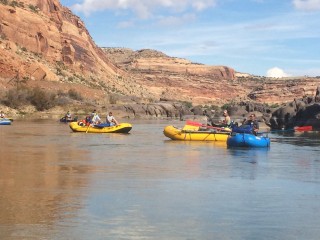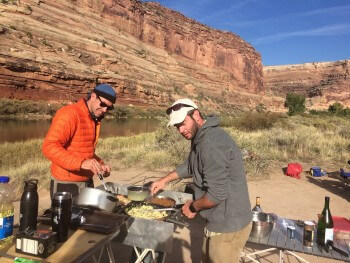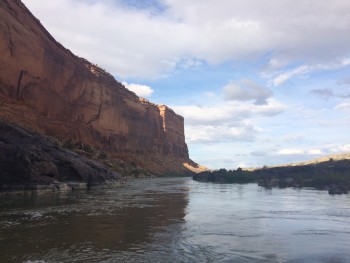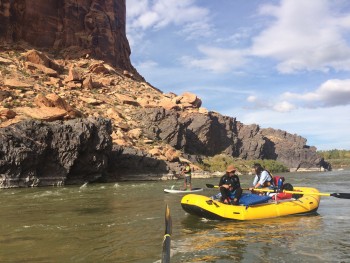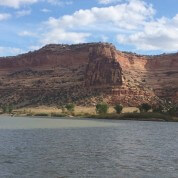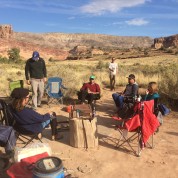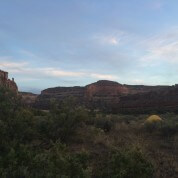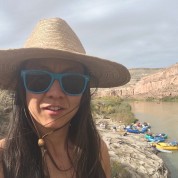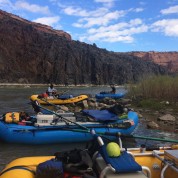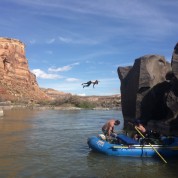River Safety & Rescue: The Safety Talk

A clear and thorough safety talk is one of the most important elements of any competent, professionally run river trip.
by Ben Costello, April 2016
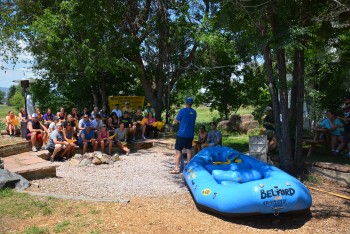
A clear and concise paddle and safety talk is a very important component to any river trip. The experience and familiarity level of the group might determine how thorough the discussion will be, but all trips should have a safety talk in some form. It should never be assumed that every member of a paddling trip is fully knowledgeable about river safety procedures and paddling techniques. Even experienced groups of paddlers should, at a minimum, briefly discuss hand signals to be used and the general plan for the trip.
A well crafted paddle talk should cover topics regarding river safety, proper equipment use, the trip plan and how to paddle. The talk should be informative, but also fun. It should be a thorough enough to cover everything needed, but not so long that people stop listening. 15 to 20 minutes is perfect.
On a lot of trips, the safety talk is conducted at the river put-in. At Mountain Whitewater, we conduct our paddle talks at our office. This allows for guest to be focussed on the safety talk without the distraction of looking at the river. The trip leader will conduct the safety talk for each trip. This allows for the trip leader to properly evaluate the group and interject their own style and humor to the talk. Each guest is given a copy of the safety talk check-list so they can follow along, with one guest checking items off the list as they are covered by the trip leader to ensure all topics are covered. The following is an example of a safety talk and the topics that should be included.
Introduction and equipment:
- Greeting and introduction.
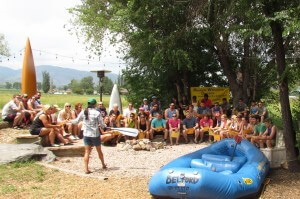 Outline of the plan for the day, length of trip, weather and brief itinerary.
Outline of the plan for the day, length of trip, weather and brief itinerary.
- The importance of quality safety gear – we use self-bailing boats with toe straps to help keep you in the boat, class V lifejackets to give great floatation, splash jackets and fleece for added warmth, and kayak style helmets to protect from rocks and flying paddles.
- Lifejackets – Make sure they are tight so that when we pull up on the shoulder straps it stays in place. Wear your lifejacket at all times. Do not undo any of the buckles or straps.
- Paddle boats – All of our trips are paddleraft trips. Team of paddlers listens to the guides’ commands to get the boat downriver. This is a team activity, everyone will need to participate and paddle.
Paddling and commands:
- holding a paddle – Always have one hand on the t–grip (top of the paddle). The other hand when paddling will be as close to the blade as possible,
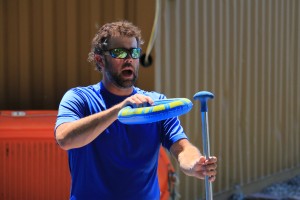
- forward paddle
this gives better leverage. The more leverage you
have, the less work you do.– Put the blade in the water in front of you and then bring it back. - back paddle – Put the blade in the water behind you and then bring it forward using your hip as a fulcrum point.
- left turn – Left side back paddles, right side forward paddles
- right turn –Right side back paddles, left side
forward paddles. - stop –Stop paddling
- hold on or bump or lean-in – Get ready for a bump, brace yourself
- high side – If the boat is going to hit a large rock with force, we all need to jump onto the tube that is going to hit the rock; the high side is always downstream. Wait for the guide to call high side, jump to the downstream tube as fast as possible, and wait for the guide to tell you to return to your positions.
- Intensity of the guides’ voice – As things get more intense the guides voice reflects that, start paddling harder.
- Importance of paddling – The motor of the boats is you and your paddle. If you turn off the motor then the boat has no steering, power or brakes. Paddle hard.
River safety and rescue:
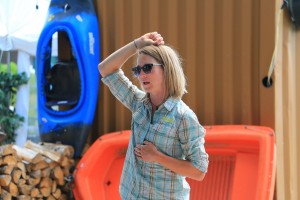
- Swimming – This is a rocky, low-volume river. When swimming, keep your feet downstream, float flat on your back and bounce off rocks with your feet. Get to shore, your boat or another boat. Keep your eyes open for a rope bag. If the water is deep, turn on your stomach and swim to the closest safe spot. If not, back paddle with your arms and legs.
- Foot entrapment – Do not stand up in the river. Your foot could become lodged underneath a rock, the current pushes you forward, and suddenly you are stuck face down in the water. Sounds terrifying! DON’T stand in moving water.
- Flipping – Occasionally boats can and do flip over. Follow all the same swimming procedures; the boats stay afloat whether right-side-up or upside-down. Do not hold onto the downstream side of the boat because we don’t want anyone smashed between the boat and downstream rocks.
- Finding yourself underneath the boat – Get out from there. Put your hands above your head and push on the boat, use them like you are walking with your hands. Pick one direction and keep going.
- Point positive – The guides may point while you are swimming, go that direction. We are pointing which way to go, not to look out for something. The faster they point, the faster you should go that way.
- Rope bag –
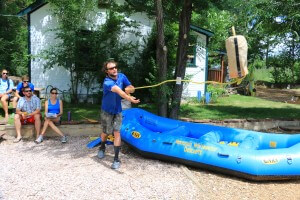 all have bags full of rope to tow you in if you get away from the boat. Keep your eyes open for ropes coming from your boat, other boats or shore. Swim to get the rope. Hold onto the rope, not the bag, and put it over your shoulder. We will tow you in backwards.
all have bags full of rope to tow you in if you get away from the boat. Keep your eyes open for ropes coming from your boat, other boats or shore. Swim to get the rope. Hold onto the rope, not the bag, and put it over your shoulder. We will tow you in backwards.
- Other boats – Other boats are happy to pull you in, go to whomever is closest. If a kayaker is towing you, grab onto the rear tow strap, kick hard with your feet. They will tow you to shore. Do not grab any other part of their boat, paddle or them.
- Pulling someone in –Grab them by the shoulder straps of their lifejacket, brace your knees on the boat and fall backwards. Use your body weight not your arms. The person being pulled in should kick with their feet, just like getting out of a pool. If you still can’t get them in dunk them down into the water so that the buoyancy of the lifejacket can help you out (make sure you let them know what you are doing).
- Strainers – Strainers are objects in the river like trees or branches that allow water to flow through but not people. Swim aggressively away from strainers. If you cannot swim away from the object, fight your way over the strainer, never allow yourself to swim under the strainer.
Other topics:
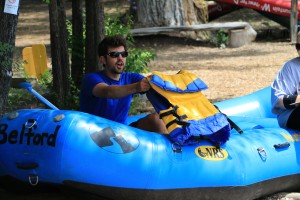
- Water Fighting – Water fighting is allowed on warm days for willing parties. Don’t splash if someone doesn’t want to. Watch for flailing paddles, don’t splash or squirt someone in the face. Stay in your raft. Do not water fight above rapids.
- Any medical condition that we should know about? Please let your guide know about any medical conditions or drugs that you are taking that may help us in an emergency.
- Litter – If we catch anyone marring our beautiful office, you will be boatless. Seriously, we want to keep this beautiful for us and everyone else. Everything that we bring in, we bring out. There is also recycling available at the shop.
- Get Your Gear – Follow guides to get your gear. Please be prudent as we are on a strict time schedule. The order you wear your gear from bottom to top is: bathing suit, wetsuit, fleece, splash jacket and then your pfd.
- Natural Flowing Rivers – We do not expect all of these things to happen, however, this is a naturally flowing river, you are not at Disney Land, so it is possible for some of these things to happen.
Rafting the Colorado River: An Employee Trip
Mountain Whitewater employees celebrate another great season by participating in a multi-day trip rafting the Colorado River.
By Ben Costello, November 2015
It was another great rafting season on the Cache La Poudre River for Mountain Whitewater, one of the best ever in fact. There were great water levels throughout the season and entertaining music at the Paddler’s Pub. A fantastic crew of employees and all our wonderful guests contributed to making 2015 a rafting season to remember. The staff at Mountain Whitewater worked hard all season to ensure a great experience for everyone involved. After all of that hard work, it was time for a group of employees to celebrate the season by going on a multi-day rafting vacation.
In mid October, with permits secured, food packed and rafting and camping equipment secured in trucks, our group of twelve guides headed to Western Colorado for a trip rafting the Colorado River. The plan for the devoted band of river rats was to launch just west of Frutia, Colorado and head down river to spend five days running the Ruby-Horsethief and Westwater Canyons of the Colorado River.
Those who have never experienced an over-night rafting trip often assume the trips are strenuous and rough. Traveling with minimal gear while eating freeze dried food, like backpackers. That is not the case for most rafting trips. Rafts can accommodate lots of gear, a full kitchen, large, comfortable sleeping pads, camp chairs, fire pans, plenty of beer and lots of other creature comforts. Our trip rafting the Colorado River included meals like lasagna, eggs and bacon, steak shish-ka-bobs with artichoke dip, Reuben sandwiches, chicken fajitas and pineapple upside-down cake. Camps were comfortable, even luxurious by camping standards.
The first part of the journey traveled through the Ruby and Horsethief canyons. This particular stretch of the river contains mostly placid, class I and II water and beautiful desert landscape. Huge red rock walls, calm green water and aromatic desert shrubs are experienced along the way. Birds of prey ride the drafts off the canyon walls while fish jump, leaving ripples on the water surface. It’s a perfect setting for a relaxing row by the oarsmen (and women) captaining the seven rafts on the trip. Two of the guides paddled stand up paddleboards while others simply rode on the bow of a raft. Regardless of the mode of travel, each member of the group enjoyed being out in the desert away from the hustle and bustle of real life. Spending time on a desert river allows for the unmistakable feeling of freedom without worry. No electronic devices, no bills to pay, just the great outdoors with great friends.
The group spent the first couple days of our adventure on this part of the river. Popular activities included playing in the water, relaxing by the fire and playing Bocce Ball or Washers. On our layover day, most of the group hiked up Mee Canyon. I stayed back to wait for a couple of our other guides friends who would be meeting us at camp that day. It was nice to spend time soaking in the view. I watched river otters play and waved at other groups of rafters heading down river. We left camp the next day and spent time jumping off the rocks in the Blackrock area before moving on to the Westwater Canyon section of the Colorado River for some exhilarating class III and IV whitewater.
Westwater Canyon is one of the most popular overnight river trips in the Western Colorado/Eastern Utah area. It is the only place, other than the Grand Canyon where a whitewater traveler can see Precambrian rocks like Vishnu Schist and Zoroaster Granite. These rocks and the large, steep canyon walls give it a feel very similar the Grand Canyon. The short, but action packed section of whitewater within the Westwater Canyon area provide for a very wet and wild experience for river runners.
Rafting the Colorado River in Westwater Canyon did not disappoint for our employee trip. We saw mostly warm sunny weather, with just a little rain while running the rapids when you are wet anyway. Most all of the rapids were run successfully by the seasoned guides, smashing through large waves while smiling with joy. One raft, a smaller mini-me did flip in one of the larger rapids called Skull. The raft hit the main, large hydraulic in the rapid and was flipped instantly. But that was not unexpected because rowing a raft as small as the mini-me makes for a wild ride. All went well as the raft was easily righted once it was pulled into an eddy after the rapid. For our group, there is nothing more satisfying than traveling together on a river and running big rapids.
The trip ended with one final night at camp with rowdy campfire discussions about the day of running whitewater. Final rounds of washers and bocce ball were played to determine trip champions and the group enjoyed one last gourmet camp meal. It was another memorable addition to the river logs of the veteran guides and an unforgettable first multi-day experience for a few others. The trip fortified the already tight bond between coworkers. Can’t wait to do it again. A multi-day adventure rafting the Colorado River, or any other river for that matter, is an unbeatable experience. And for our group, it was a perfect way to unwind and celebrate another season doing what we love: guiding rafts on the Cache La Poudre River.
photos by Melissa Matsunaka
2015 Projected Flow for Poudre River Above Average
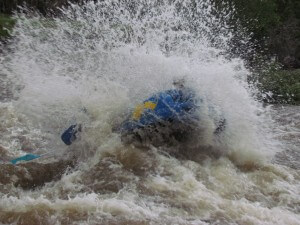 As of March 1, 2015 the Cache La Poudre River spring and summer flow is forecast to be at levels around 103% of average flows. This is according to the Colorado Water Supply Outlook Report issued by the US Department of Agriculture, Natural Resource Conservation Service (NRCS).
As of March 1, 2015 the Cache La Poudre River spring and summer flow is forecast to be at levels around 103% of average flows. This is according to the Colorado Water Supply Outlook Report issued by the US Department of Agriculture, Natural Resource Conservation Service (NRCS).
NRCS issues a monthly report from January to June every year that outlines snowpack levels, precipitation amounts, reservoir storage and stream flow forecasts for the different river basins in the State of Colorado. The Cache La Poudre River is a sub-basin of the larger South Platte River basin that covers most of northeast Colorado on the east side of the continental divide. Overall, the South Platte basin has seen 110% of median snowpack levels this past winter and has the highest on average stream flow forecasts for 2015 for each of its sub-basins (Cache La Poudre, Big Thompson, Boulder-St. Vrain, Clear Creek and Upper South Platte) compared to other basins in the State.
The streamflow forecast for the Cache La Poudre River comes as great news for recreation, as average to high snowpack levels translate to better water conditions. While there is still time for variations in the snowpack levels and ultimately spring and summer streamflows, above average numbers in March usually lead to very exciting peak levels in June and sustained water levels throughout the summer season. Another bit of good news from the report is that reservoir storage levels in the Cache La Poudre basin are also near or above average as well.
“We are very excited to see streamflow forecast near or above 100% of average for the Poudre River. Great water conditions are exciting for our staff and provide for an unforgettable rafting experience for our guests” says Ben Costello, Director of Fun for Mountain Whitewater.
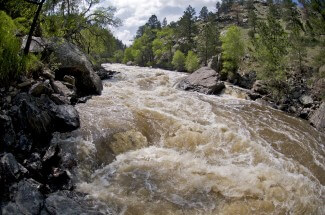 “We are looking forward to another fantastic season and cannot wait to start taking our guests down this very special river.”
“We are looking forward to another fantastic season and cannot wait to start taking our guests down this very special river.”
Whitewater rafting on Colorado’s only “Wild & Scenic River” is always a unique and memorable experience, but good water conditions make things even better. If a fast paced trip is what you seek, be sure to book your 2015 rafting trip in May or June for the most exciting water conditions. As long as we continue to see average snow fall amount in March and April (typically the best months for snow in Colorado), conditions for rafting on the Cache La Poudre River will be fantastic for the entire 2015 river season.
Follow this link to the Basin Outlook Report to read the entire report for yourself or to check on forecast conditions around the rest of our beautiful state.
Guided ducky trips with Mountain Whitewater
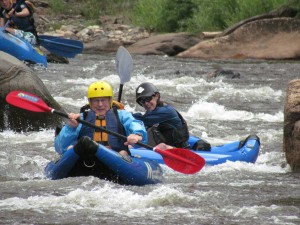
Cass (Black helmet) guides a ducky trip.
Inflatable Kayaks (also known as ‘Duckies’) are perfect for the adventure seeker in all of us. Duckies offer more independence to the paddler in a smaller boat that makes every wave seem much bigger! Inflatable Kayaks offer the sensation of kayaking but with better stability for the beginner to intermediate user.



